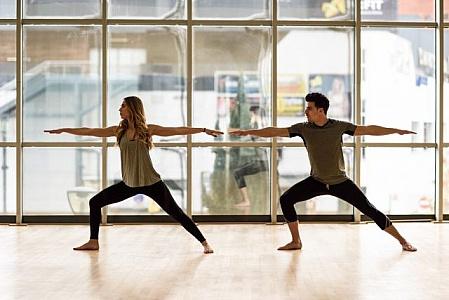Exploring the Harmony of Two-Person Yoga Poses
Introduction:
Yoga is a practice that promotes unity, not just within ourselves but also with others. While many envision yoga as a solitary practice, there's a beautiful dimension to exploring it with a partner. Two-person yoga poses, also known as partner yoga, offer an opportunity to deepen connections, build trust, and enhance communication while experiencing the benefits of yoga together. Let's delve into the world of two-person yoga and explore some poses that can be practiced with a partner.
Benefits of Partner Yoga: Partner yoga goes beyond the physical benefits of individual practice. It fosters a sense of connection, encourages teamwork, and cultivates trust and communication between partners. Additionally, practicing yoga with a partner can provide a deeper stretch, enhance balance, and help improve alignment by assisting each other in achieving proper posture.
- Partner Boat Pose (Navasana):
- Sit facing each other with your knees bent and feet flat on the ground.
- Hold hands and lift your legs, bringing the soles of your feet to touch.
- Straighten your legs as much as possible while maintaining balance.
- Engage your core and find stability by leaning back slightly.
- Hold the pose for several breaths, supporting each other's balance.
- Double Downward Dog (Adho Mukha Svanasana):
- Start in a traditional downward dog position.
- One partner assumes the downward dog position while the other partner stands behind, placing their hands on the first partner's hips.
- The partner in front walks their feet back towards the partner behind, creating a stable triangle shape.
- Both partners should focus on lengthening their spine and pressing their hands firmly into the ground.
- Hold the pose for a few breaths, then switch roles.
- Partner Seated Forward Bend (Paschimottanasana):
- Sit facing your partner with your legs extended in front of you.
- Reach out and hold each other's hands.
- As you inhale, lengthen your spine, and as you exhale, gently fold forward, keeping your back straight.
- Your partner can gently assist by applying a slight pressure on your back, helping you to deepen the stretch.
- Hold the pose for several breaths, feeling the stretch in the hamstrings and lower back.
- Partner Tree Pose (Vrksasana):
- Stand side by side with your partner, facing the same direction.
- Shift your weight onto one foot and lift the opposite foot, placing the sole against the inner thigh or calf of the standing leg.
- Join hands with your partner or place them on each other's shoulders for balance.
- Find a focal point to help with balance and stability.
- Hold the pose for a few breaths, then switch sides.
Conclusion: Two-person yoga poses offer a unique opportunity to deepen connections, build trust, and enhance physical and emotional well-being. Whether practiced with a friend, family member, or significant other, partner yoga provides a platform for shared experiences and mutual support. By exploring these poses together, partners can strengthen their bond while reaping the numerous benefits of yoga practice. So grab a partner, roll out your mats, and embark on a journey of harmony and connection through two-person yoga.
